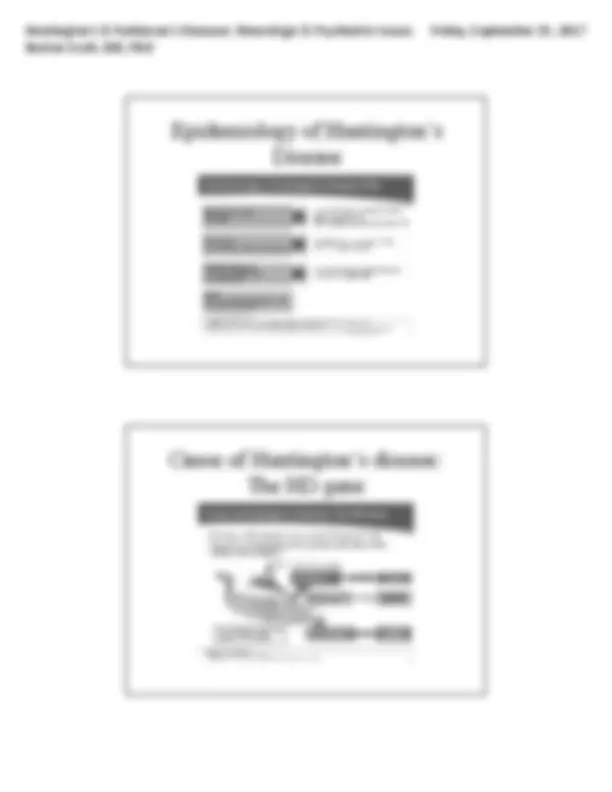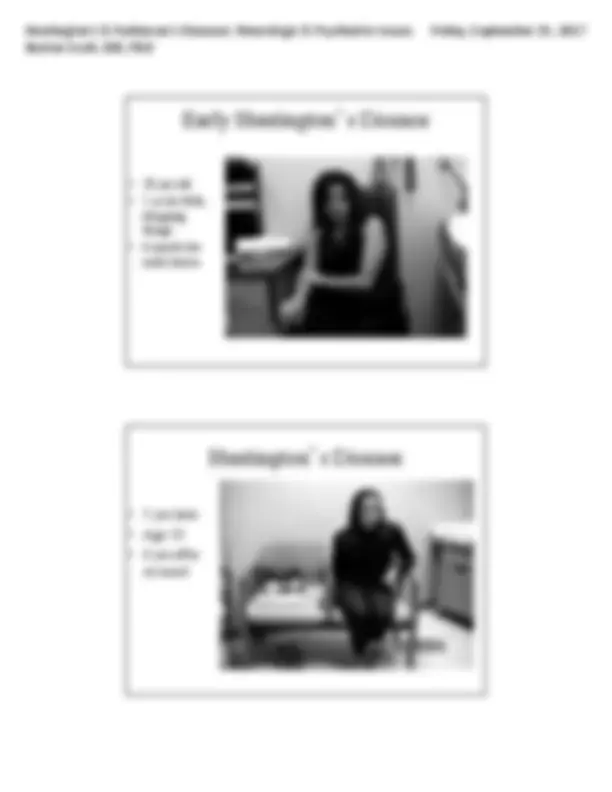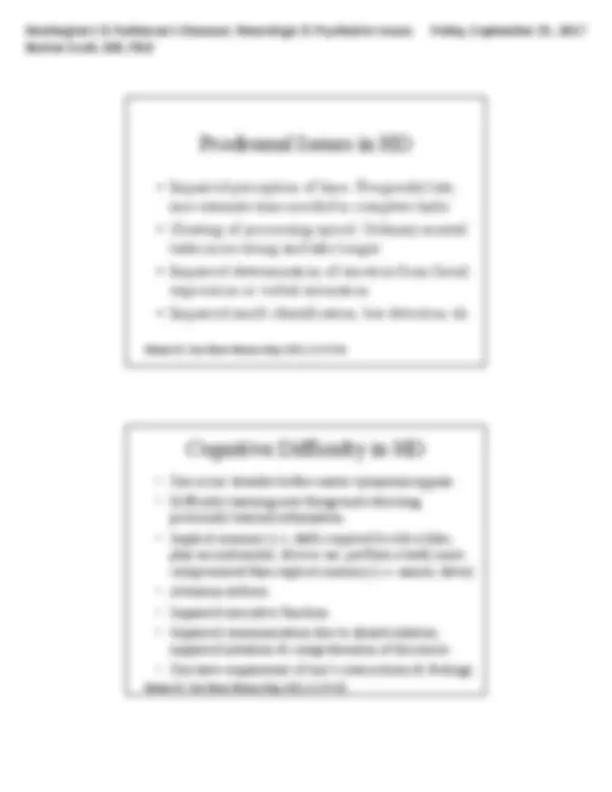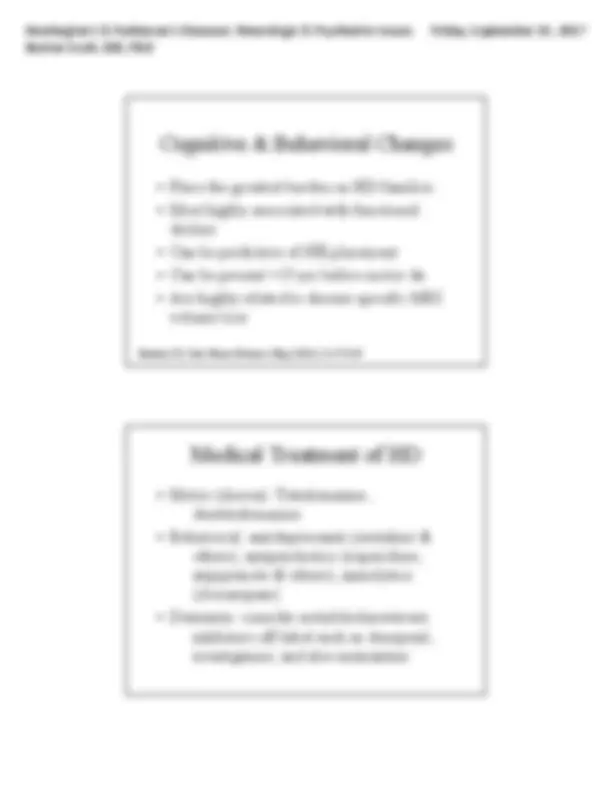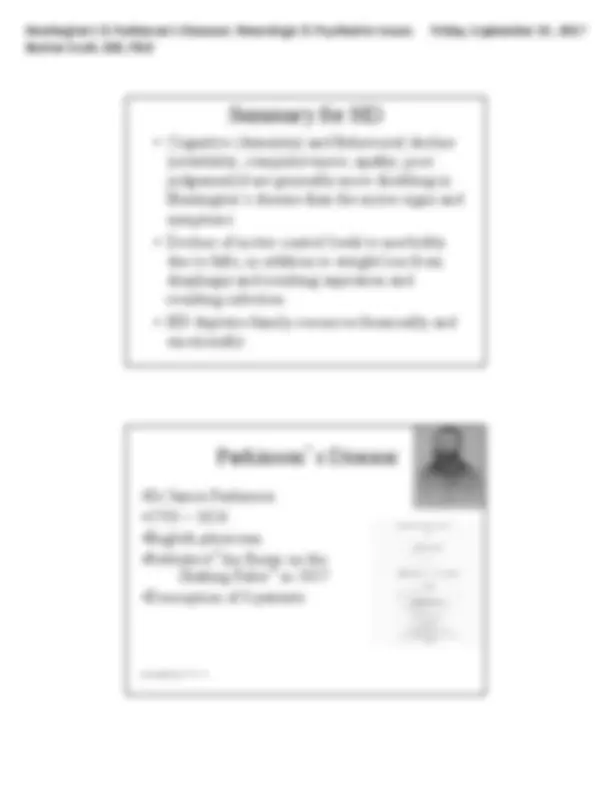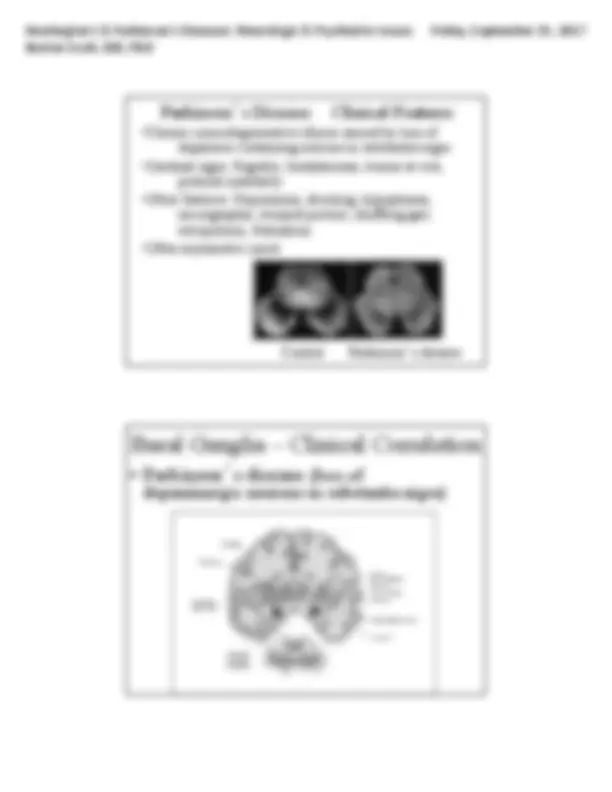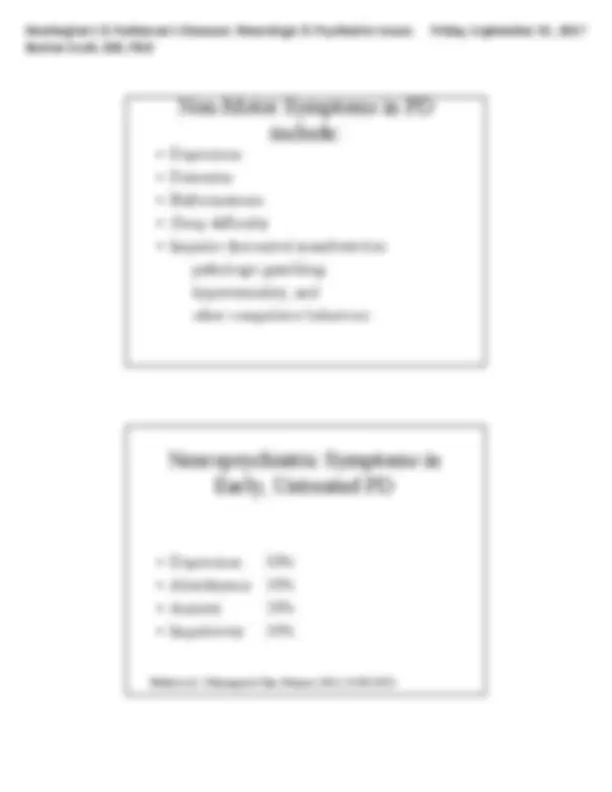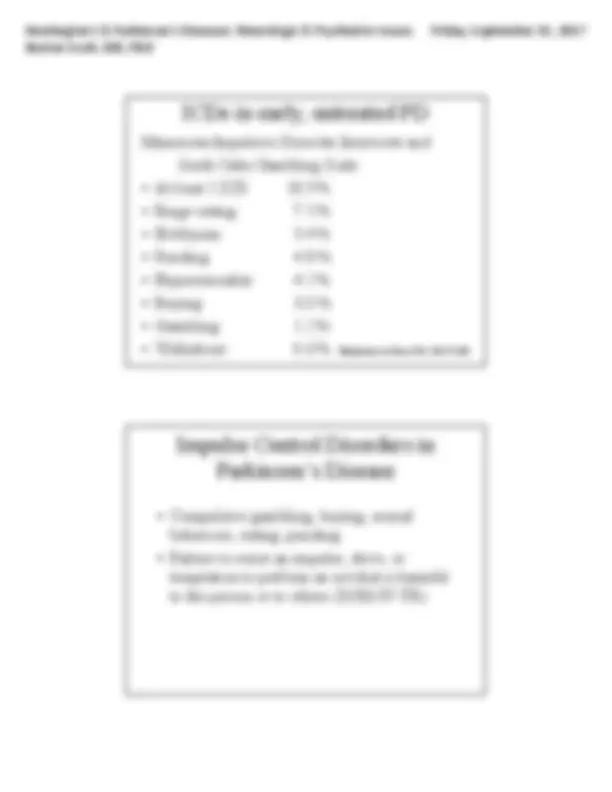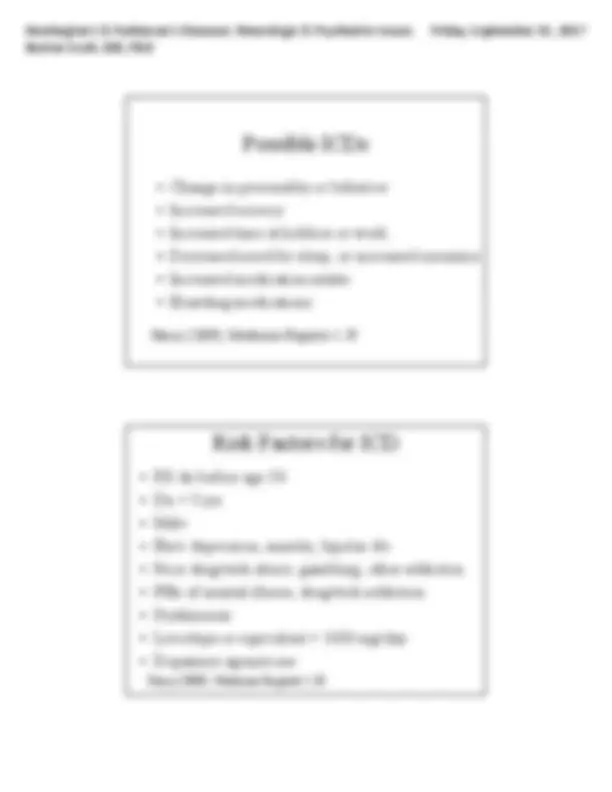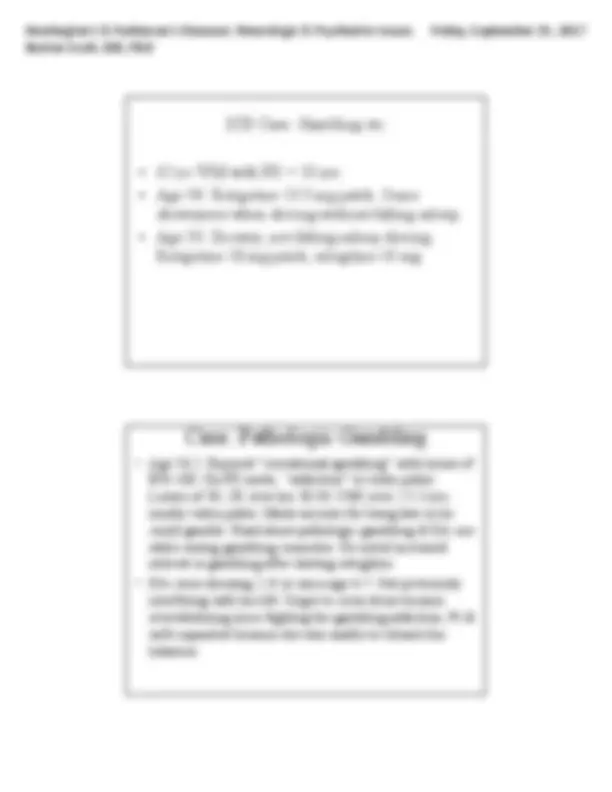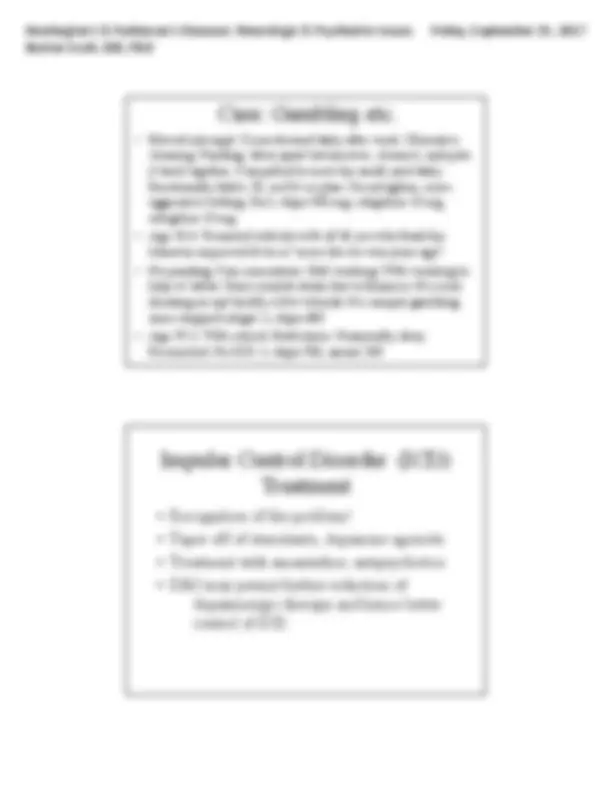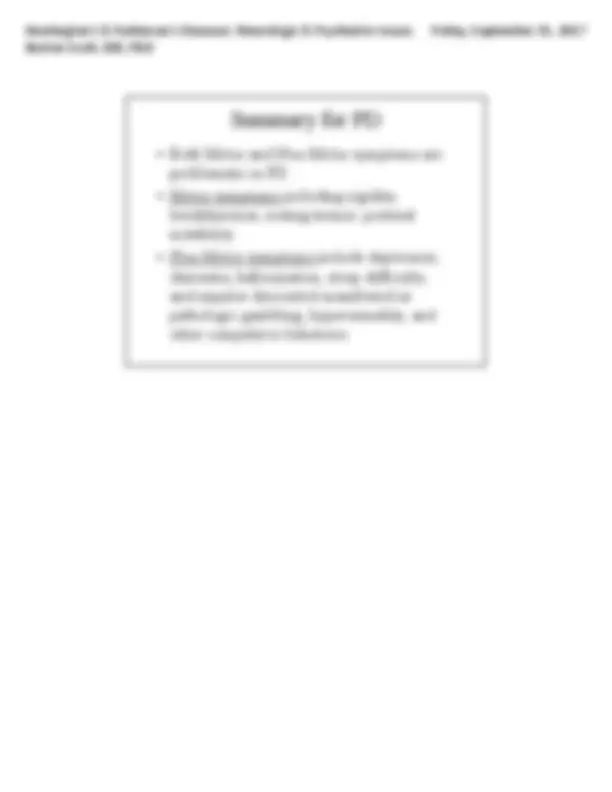Download Neurologic & Psychiatric Issues Huntington's Disease and more Study notes Psychiatry in PDF only on Docsity!
Burton Scott, MD, PhD
Huntington’s & Parkinson’s Diseases:
Neurologic & Psychiatric Issues
Burton Scott PhD, MD Duke Movement Disorders Center Durham, NC
Huntington’s Disease
- Typically adult-onset, autosomal dominant disorder characterized by involuntary movements (chorea), dementia, and behavioral changes
- 25,000 affected w/ HD in USA
- Loss of medium spiny neurons from caudate/putamen
- Chm 4p16.3 CAG repeats
Huntington G. On chorea. Med Surg Report 1872; 26:
George Huntington 1850 - 1916
Burton Scott, MD, PhD
Triad of Symptoms of HD
Basal Ganglia
• Huntington’s disease
(loss of medium spiny neurons in striatum:
Burton Scott, MD, PhD
Early Huntington’s Disease
- 28 yrs old
- 1 yr h/o falls, dropping things
- 6 month h/o mild chorea
Huntington’s Disease
- 5 yrs later
- Age 33
- 6 yrs after sx onset
Burton Scott, MD, PhD
Prodromal Issues in HD
- Impaired perception of time. Frequently late, mis-estimate time needed to complete tasks
- Slowing of processing speed. Ordinary mental tasks more tiring and take longer.
- Impaired determination of emotion from facial expression or verbal intonation
- Impaired smell identification, but detection ok.
Paulsen JS; Curr Neuro Neurosci Rep (2011) 11:474-
Cognitive Difficulty in HD
- Can occur decades before motor symptoms appear.
- Difficulty learning new things and retrieving previously learned information
- Implicit memory (i.e. skills required to ride a bike, play an instrument, drive a car, perform a task) more compromised than explicit memory (i.e. names, dates)
- Attention deficits
- Impaired executive function
- Impaired communication due to dysarticulation, impaired initiation & comprehension of discourse.
- Can have impairment of one’s own actions & feelings Paulsen JS; Curr Neuro Neurosci Rep (2011) 11:474-
Burton Scott, MD, PhD
Depression symptoms occur early
in HD
Burton Scott, MD, PhD
Cognitive & Behavioral Changes
- Place the greatest burden on HD families
- Most highly associated with functional decline
- Can be predictive of NH placement
- Can be present >15 yrs before motor dx.
- Are highly related to disease specific MRI volume loss
Paulsen JS; Curr Neuro Neurosci Rep (2011) 11:474-
Medical Treatment of HD
- Motor (chorea): Tetrabenazine, deutetrabenazine
- Behavioral: antidepressants (sertraline & others), antipsychotics (risperidone, aripiprazole & others), anxiolytics (clonazepam)
- Dementia: consider acetylcholinesterase inhibitors off-label such as donepezil, rivastigmine; and also memantine
Burton Scott, MD, PhD
Parkinson’s Disease: Clinical Features
•Chronic neurodegenerative illness caused by loss of dopamine-containing neurons in substantia nigra •Cardinal signs: Rigidity, bradykinesia, tremor at rest, postural instability •Other features: Hypomimia, drooling, hypophonia, micrographia, stooped posture, shuffling gait, retropulsion, festination •Often asymmetric onset
Control Parkinson’s disease
Basal Ganglia – Clinical Correlation
• Parkinson’s disease (loss of
dopaminergic neurons in substantia nigra)
Burton Scott, MD, PhD
Parkinson’s Disease
Burton Scott, MD, PhD
Non-Motor Symptoms in PD
include:
- Depression
- Dementia
- Hallucinations
- Sleep difficulty
- Impulse dyscontrol manifested as: pathologic gambling hypersexuality, and other compulsive behaviors.
Neuropsychiatric Symptoms in
Early, Untreated PD
- Depression 33%
- Alexithymia 20%
- Anxiety 20%
- Impulsivity 10%
Poletti et al. J Neuropsych Clinc Neurosci 2012; 24:E22-E23.
Burton Scott, MD, PhD
ICDs in early, untreated PD
Minnesota Impulsive Disorder Interview and South Oaks Gambling Scale
- At least 1 ICD 18.5 %
- Binge eating 7.1 %
- Hobbyism 5.4 %
- Punding 4.8 %
- Hypersexuality 4.2 %
- Buying 3.0 %
- Gambling 1.2 %
- Walkabout 0.6 % Weintraub et al, Neur, 2013; 80:176-180.
Impulse Control Disorders in
Parkinson’s Disease
- Compulsive gambling, buying, sexual behaviors, eating, punding
- Failure to resist an impulse, drive, or temptation to perform an act that is harmful to the person or to others (DSM-IV-TR)
Burton Scott, MD, PhD
Cerebral Blood Flow in ICD vs
non-ICD Parkinson’s Disease Pts
Rao et al (2010) Mov Disord 25:1660-
Impulse Control Disorder: Cross Dressing
- 82 yo WM with PD. Onset age 70 with decreased dexterity at L hand when typing.
- FHx: Sister with schizophrenia. Mom (d) suicide when pt was age 2. Two children.
- SHx: Flew jets in the military. Married for 55 yrs.
- 73: Urge to cross dress since prostate surgery, w/ incr urges since starting PD meds. Ropin 9 mg, selegiline 5 mg, l-dopa 200 mg
- 73.6: Sees psych for recurr depression. Awakes w/ urge to cross dress.
- 74.1: Psych: urge to wear woman’s clothes,? rel to mother leaving him (suicide) and having 3 step-mothers as child. Stays active to fight cross dressing urges
- Age 82: Still has urges to wear women’s undergarments. On l-dopa 900, ropinirole 4, olanzapine 10 (after hospital’n for psychosis, later tapered off), ritalin 10
Burton Scott, MD, PhD
ICD Case: Compulsive Fishing
- 49 yo WM. Onset PD age 40 w/ sl hand tr, decr L hand dexterity typing.
- FHx: sister bipolar; brother w/ tremor
- SHx: Heavy etoh in college; Navy grad; Married w/2 kids. Executive
- Dxd PD age 41, started pramipexole
- 45: Fishes compulsively “about 1 hr daily”, but says, “I don’t have to every day”. “Not a problem”. On L-dopa 800-1000, pram 3; clonaz 2
- 46: Fishing compulsively. Trip to Brazil to fish.
- 47: Eats compulsively. Daytime sleepiness. Rollover MVA, (? sleep driving). Inj knee jumping out of boat. Personality changes. Wife tearful & near to leaving him. Insomnia. Fixates on a topic. Intense. Pressured speech. Decreased insight. Thinks about fishing daily. L- dopa 1200, pram 2, amant 100, rasag 1 mg, modaf 100, amitrip 50
ICD: Fishing
- 48: Compuls eating. “No filter”: Says whatever he thinks. Argues, agitated. Fishes compulsively, out 8 PM to 5 AM. On- line poker. Easily distracted. Unable to multitask. Wild dreams. L-dopa 13-1400, entac 1200, pram 2, amant 100, rasag
- May double meds.
- Then: Wife discovered he spent $100’s at a strip club when supposedly out all night fishing. Frequented strip clubs in past, now much more often. Wanted to change, reduce PD meds.
- 48.5: Deep Brain Stim (DBS) surgery
- By age 49: Behavior stabilized. No problems with compulsive urges. Exercising. Doing yard work.
- Taking L-dopa 500 to 600, amantadine 200
- Age 49.5: No compulsive behaviors. Home life stable.
Burton Scott, MD, PhD
Case: Gambling etc.
- Moved into appt. Cross dressed daily after work. Obsessive cleaning. Punding: takes apart lawnmower, cleans it, and puts it back together. Compelled to mow his small yard daily. Emotionally labile. SI, no SA or plan. On selegiline, more aggressive betting. On L-dopa 500 mg, rotigotine 18 mg, selegiline 10 mg.
- Age 56.6: Reunited with his wife of 36 yrs who finds his behavior improved & he is “more like he was years ago”.
- No punding. Can concentrate. Still working. Wife working to help w/ debts. Some marital strain due to finances. No cross dressing except briefly a few wkends. No compul gambling since stopped rotigot. L-dopa 400
- Age 59.3: Wife retired. Both home. Financially okay. Reconciled. No ICD. L-dopa 700, amant 200
Impulse Control Disorder (ICD)
Treatment
- Recognition of the problem!
- Taper off of stimulants, dopamine agonists
- Treatment with amantadine, antipsychotics
- DBS may permit further reduction of dopaminergic therapy and hence better control of ICD.
Burton Scott, MD, PhD
Summary for PD
- Both Motor and Non-Motor symptoms are problematic in PD
- Motor symptoms including rigidity, bradykinesias, resting tremor, postural instability
- Non-Motor symptoms include depression, dementia, hallucination, sleep difficulty, and impulse dyscontrol manifested as pathologic gambling, hypersexuality, and other compulsive behaviors.

